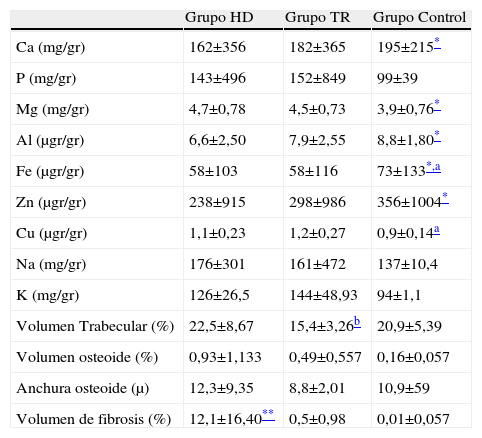El hiperparatiroidismo por enfermedad renal crónica (ERC) puede alterar la composición y arquitectura ósea, y ocasionar fracturas. La densidad mineral ósea (DMO) determinada mediante densitometría (DEXA), empleada para predecir el riesgo de fractura1, estima la cantidad de calcio presente en el hueso. Sin embargo, desconocemos la relación entre DMO y la composición del hueso.
Pacientes y métodoNuestro estudio se ha realizado en 2 grupos de pacientes con enfermedad renal que presentaban hiperparatiroidismo e intervenidos de paratiroidectomía, pacientes en hemodiálisis (grupo HD) y pacientes con trasplante renal (grupo TR). Se pretende: cuantificar y valorar las diferencias en la DMO entre estos dos grupos; cuantificar y definir diferencias en los parámetros de histomorfometrícos ósea entre estos 2 grupos y un grupo control; y definir si existe relación entre la DMO, elementos óseos y parámetros histomorfométricos.
ResultadosEl valor medio de la DMO en fémur fue superior en el grupo TR que en el grupo de HD. Del análisis de correlacion lineal realizado entre parámetros de DMO versus elementos en hueso e histomorfometría, considerando en conjunto TR y HD, únicamente observamos correlación entre DMO en fémur (gr/cm2) y calcio (r=0.435, p= 0.034, n=24).
ConclusionesLos pacientes con hiperparatiroidismo intervenido con TR tienen mejor DMO femoral que aquellos en HD. El volumen trabecular es inferior en TR, mientras que el volumen de fibrosis es superior en HD. Los elementos en hueso en TR y en HD se encuentran en proporción semejante, si bien el contenido de calcio tiende a ser superior en TR.
Hyperparathyroidism (HPT) in chronic kidney disease (CKD) may alter the composition and bone architecture, and cause fractures. The DEXA bone mineral density (BMD), used to predict fracture risk, measures the amount of calcium in bone. However, we do not know the relationship between BMD and bone composition.
Patient and methodOur study, conducted in two groups of renal patients with HPT who underwent parathyroidectomy (PTX): patients on hemodialysis (HD group) and patients with renal transplant (RT group). The aims were to quantify and value the differences among groups and by gender on bone mineral density, quantify and define differences between these two groups and a control group regarding the elemental composition of bone marrow biopsy obtained and static parameters of bone histomorphometry, and define a possible relationship between bone mineral density and bone elements versus histomorphometric parameters.
ResultsThe BMD mean in femur was higher in TR group than in HD group. Linear correlation analysis performed between parameters versus BMD and bone histomorphometry elements, considering both TR and HD, only correlation between femur BMD (gr/cm2) and calcium (r=0.435, p=0.034, n=24) was observed.
ConclusionHyperparathyroidism patients undergoing renal transplant had better femoral BMD than those on hemodialysis; the trabecular volume was lower in kidney transplantation, while the volume of fibrosis was higher in hemodialysis patients; the elements in bone transplant and hemodialysis were in similar proportion, while the calcium content tended to be higher in renal transplant.
Artículo
Comprando el artículo el PDF del mismo podrá ser descargado
Precio 19,34 €
Comprar ahora









